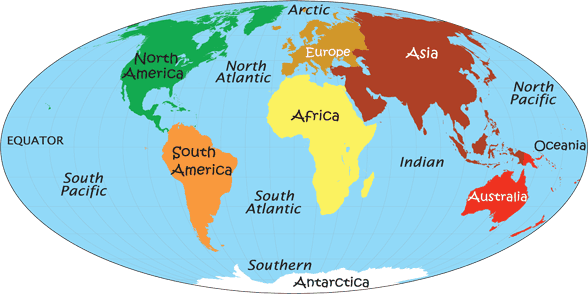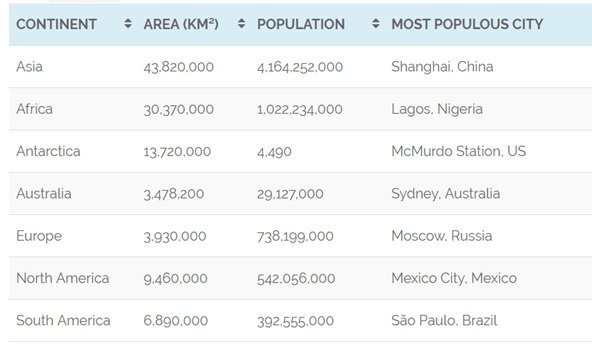The List of 7 Continents and 5 Oceans of the Earth
Throughout this lifetime and with the many advances in technology in the field of astronomy, no one has ever been able to spot a planet similar to the diversity as that of our Planet Earth. Our planet, our mother Earth, despite being like the size of a needle in a haystack in the whole of the universe is home to millions and millions of living creatures big and small.
Large masses of land and wide bodies of water known as continents and oceans comprise the environment we have on Earth. As beautiful as it may look now, it has not always been like this. Events that took place from the earliest single celled life until the Ice Ages have resulted to that single huge mass of Earth to split and separate from each other bordered by the bodies of water. This process has resulted to the 7 continents and 5 oceans and this is still on going.
The 7 Continents of the World
Polar researchers has made scientific theories that some million years ago, there were but supercontinents. Tectonic plate movements throughout the history of the Earth have caused these supercontinents to collide and break into smaller masses of land as continents. This was theorized as Continental Drift. The seven continents; Africa, Antarctica, Asia, Australia, Europe, North America, and South America were the product of the Continental Drift. The theories have evolved over the years contradicting each other but however it is called or theorized now, there is no doubt these seven continents have been positioned effectively to support human and animal life.
Before going over each of these continents, let’s take a look at some details on the map and the table below;


Africa
Coming behind Asia in terms of being the largest and most populous continent is Africa. At 11.7 million square miles, it covers 6% of the Earth’s total surface area and 20% of its land area. With 1.2 billion people as of 2016, it interprets 16% of the world’s human population. Africa, based on theories of paleoanthropologists is considered to be the oldest inhabited territory. Fossils discovered in the 20th century proved of human occupation as early as 7 million years ago. The climate in Africa which ranges from tropical to subarctic on its highest peaks have made it the ideal environment to a lot of endangered species.
The continent is bordered by Mediterranean Sea to the north, Isthmuz of Suez and Red Sea to the northeast, Indian Ocean to the southeast, and Atlantic Ocean to the west. The median age in Africa is 19 while the worldwide median age is 30.4. Therefore making their average population the youngest among the continents.
Antarctica
The fifth largest continent is Antarctica. With 5.4 million square miles it is about 1.3 times as large as Europe. Being the Earth’s southernmost continent located in the Antarctic Region of the Southern Hemisphere, it contains the geographic South Pole. About 98% of this continent is covered by ice sheets averaging to at least 1.6 kilometer thick. It is the coldest of Earth’s continents. As the weather makes it unbearable to live, only about 1000-5000 people inhabit Antarctica. There is no economic activity here except for fishing and small scale tourism.
Only animals adapted to dryness and low temperatures are common in Antarctica. Low temperatures and high exposure caused little biodiversity here compared to the rest of the world.
Asia
Known to everyone, Asia is the major and most populous continent on Earth. Located primarily in the Eastern and Northern Hemisphere, it is bordered by Pacific Ocean, Indian Ocean and Arctic Ocean. Asia covers Earth’s total surface area by 71.n square miles and has the largest coastline at 39,022 miles as well. This is home to 4.5 billion people from about 50 countries.
There is no clear geographical separation between Europe and Asia therefore they are commonly called Eurasia. Only a historical and cultural construct stands as the border between the two. Given the land size, and the huge amount of people, diversity varies across regions with regard to ethic groups, culture, economics and government systems.
Australia
Situated in the graphical region in Oceania, Australia is the smallest of the continents. Its total land area of 3.3 million square miles, it is home to 29 million of the world’s population and biodiversity. As the rest of the world undergoes significant cooling, Australia has its global cooling effect remain reasonably constant by its gradual movement toward the equator. For that, enormous diversity of animal, fungal and plant life have developed.
Earliest human migrations including that from out of Africa make up the original inhabitants of Australian continent. Immigration to this continent have brought overseas language that make up about 200 that they have. Large proportions of Australia belong to no region while Christianity is predominant in those practicing faith. As small continent as it is, they have Australia which is the only first world country having the largest and most dominant economy in the region. They have federal parliamentary constitutional monarchy with two major political groups that form the government.
Europe
Bordered by the Arctic Ocean to the north, Atlantic Ocean to the west and Mediterranean Sea to the south is the continent of Europe located entirely in the Northern Hemisphere and mostly in the Eastern Hemisphere. The second smallest continent, it covers about 3.9 million square miles or 2% or Earth’s surface. It is divided to fifty sovereign states with Russian Federation having the largest and most populous.
Ancient Greece in Europe was the birth place of Western Civilization. Between 16th and 20th centuries, it controlled at various times the Americas, almost all of Africa and majority of Asia. Two world wars and an economic depression drew most European nations that dominated early 20th century. Europe has a continually evolving politics factored by the historical events within the continent.
North America
North America covers an area of about 9.5 million square miles or 16.5% of Earth’s land area and 4.8 of its total surface. It is the third largest by area and the fourth by population. North America has many regions and subregions. The largest countries of this continent are Canada and the United States. By demographics, North America is ethnically diverse as there are groups of Caucasians, Mestizos, and Blacks. Significant minority of Indigenous Americans and Asians are present. North America’s Economy is flawless that when their GDP per capita was evaluated in October 2016, it appeared as the richest continent in the world.
South America
South America also considered as a subcontinent of the Americas is a continent in the Western Hemisphere, mostly in the Southern Hemisphere with a small portion in the Northern Hemisphere. It is the fourth largest continent with an area of 6.8 million square miles. The population is the 5th amongst the 7 continents at nearly more than 420 million. Majority of the population live near the continent’s western or eastern coasts.
The long history of colonialism, majority of South Americans speak Spanish. Indigenous people’s interaction with European conquerors and immigrants was the basis of the continent’s cultural and ethnic outlook. South America has been home to many interesting species of animals. The rainforests of Amazon has made this continent one of the most bio diverse. Manufactured goods and natural resources being exported is what South America relies on to. In terms of politics, all South American countries are presidential republics except for Peru which is semi-presidential republic and Suriname, a parliamentary republic.
The Five Oceans
Earth’s surface is covered of about 70% water. Geological History believed that oceans were formed by volcanic activity and outgassing. All the water vapor from these process have condensed into oceans, augmented by water and ice from asteroids and protoplanets. Oceans are large bodies of saline water that composes vastly of a planet’s hydrosphere. These Saline waters cover about 139 million square miles and is divided into 5; Arctic, Atlantic, Indian, Pacific, and Southern or Antarctic Ocean. Take a look at the map and table below to find out where they are situated and what part of World Ocean are they bordering.
Pacific Ocean
The largest and deepest of World Oceans is the Pacific Ocean. It extends from Arctic Ocean to Antarctic and is bounded by Asia and Australia. At 63.8 million square miles, it covers about 46% of Earth’s hyrdrosphere making it larger than all of Earth’s land area. This big body of water splits Asia and Australia from the Americas.
Salinity of Pacific Ocean varies latitudnally. When the water is near the equator it can have salinity as low as 34 parts per thousand which is less salty than in the mid latitudes because of profuse equatorial precipitation.
Arctic Ocean
The Arctic Ocean, being the smallest and shallowest of the world’s oceans is referred by most oceanographers as Arctic Sea although, IHO (International Hydrographic Organization recognizes it as ocean. Lying mostly in the Arctic north polar region in the middle of Northern Hemisphere, it is almost surrounded by Eurasia and North America. It’s salinity depends by season when the ice cover melts or freezes. It covers an area of about 5.4 million square miles which is almost the size of Antarctica.
Atlantic Ocean
Covering approximately 20% of the Earth’s surface and about 29% of its waters surface area, the Atlantic Ocean comes the second largest of the world’s oceans. It occupies an stretched out S shaped basin separating Old World (Europe and Africa) from the New World (Americas). On average, this is the saltiest ocean wherein salinity ranges from 33 to 37 parts per thousand. Processes of evaporation, precipitation river inflow and melting of sea ice directly contribute to the salinity values. As a major transatlantic route, it has contributed significantly to the development of surrounding countries. However, it also contributes to environmental issues that greatly affect this ocean. Several international treaties still attempt to reduce pollution brought by oil spills, marine debris and toxic wastes.
Indian Ocean
Named after India, the third largest ocean covering about 20% of water on Earth’s surface is the Indian Ocean. This ocean was earlier known as Eastern Ocean. Indian Ocean is the warmest in the world. It is believed that human induced greenhouse warming and scale of El Niño events trigger the strong warmin of this ocean. Because of it’s temperature, it is very ideal to host the largest groups of phytoplankton blooms. The monsoonal winds also help introduce nutrients in the upper zones where light is available for photosynthesis of these organisms’ production. Indian Ocean’s calm waters made it appropriate for maritime trade.
Southern or Antarctic Ocean
Depending on definition, Antarctic Ocean is also known as Southern Ocean. It comprises most of the southern waters encircling Antarctica. As such, it is the fourth largest of the oceans in the world. A variety of animals exist in this ocean and they rely on the phytoplanktons. Marine animals such as penguins, blue whales, orcas and fur seals are mostly included on the Antarctic sea life. However, increased solar ultraviolet radiation resulting from ozone hole has lessened phytoplanktons by as much as 15% and has started damaging DNAs of fishes. There are also offshore islands that provide nesting place for about a million birds like Albatross and Petrels every spring. Antarctic Ocean is rich in natural resources thus, all international agreements authored for wold’s oceans apply to this ocean.
*** This was originally posted at a client's website with the author as a ghostwriter.